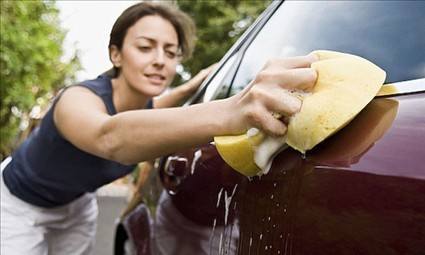
By Marc Lachapelle
Preserving the environment is a major concern these days, especially when it comes to automobiles. This even applies to some thing as seemingly mundane as preserving your vehicle's appearance. How and where you wash your car does make a difference. The matter is never more critical than in spring, when most proud car owners are busy washing off the effects of winter's unrelenting assault before it takes a toll on their pride and joy's looks, integrity and mechanical well-being.
Making a habit of keeping your vehicle as clean as possible, inside and out, will reap great benefits. A sparkling-clean car will not only flatter the eye and the owner's ego, it will also help the vehicle last longer and stay in better shape, thus improving resale value.
The question here is: What is the best and most eco-friendly way to achieve and sustain vehicular cleanliness?
Routine Cleaning
Dirt, road salt, tar and various other forms of gunk, goo and residue are your car's worst enemies. Keeping them off your vehicle's bodywork, year-round, is the basic challenge. Hand-washing a car remains the best and most effective way to do this, but it must be done the right way, and even then it is not the most environmentally friendly way to go.
These days the "greenest" way to wash your car is to run it through an automatic car wash. Studies show that a session in the car wash uses roughly half the water the average owner would use while washing it at home with the traditional bucket and hose. Commercial car-wash systems are also required, by law, to contain and collect the water used during the wash. So are professional detailers. The waste water is then cleaned and, in most cases, used again.
Automatic car-wash systems even get the nod from car-care professionals, especially when it comes to routine cleanings. David Lee, owner and operator of L.A. Detail, based in Toronto, offers thorough detailing services, but he freely admits to using commercial car-wash systems for his personal vehicle and says he finds them both useful and practical.
However, Lee is also quick to point out that not all systems are equally safe and effective. He favors the high-pressure, no-contact systems and warns against using systems with rotating brushes or moplike, moving felt mats. It's hard to assess how well-maintained these systems are, and your car's paint finish might be at the mercy of the grit that was scrubbed off the crusty old jalopy that passed through the wash just before your car. And paint could be at risk even in the best-maintained systems because of the friction generated by the brushes and mats.
High-pressure systems also are useful in performing the most difficult of tasks: cleaning off as much dirt and salt as possible from your vehicle's undercarriage, fender liners and rocker panels. The operation is entirely worth the extra couple of dollars, Lee says. "The best approach is to run your vehicle through a car wash regularly to keep the dirt from building up and digging into the surface," he says.
Lee adds that brush-free systems are at their best when only a light wash is needed. Frequency then becomes the key. Their weak point is glass, "so I always use the squeegee on glass surfaces before running my vehicle through," he says.
Article courtesy of msn.com

